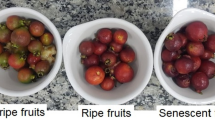Abstract
The South Pacific islanders have consumed kava beverage for thousands of years. The quality of kava and kava beverage is evaluated through determination of the content of six major kavalactones including methysticin, dihydromethysticin, kavain, dihydrokavain, yangonin and desmethoxyyangonin. In this study, we determined contents of kavalactones in and chemotype of kava beverages prepared from roots and rhizomes of Isa and Mahakea varieties and extraction efficiency of five different solvents including hexane, acetone, methanol, ethanol and ethyl acetate. The six major kavalactones were detected in all kava beverages with these five solvents. Different solvents had different extraction efficiencies for kavalactones from the lyophilized kava preparations. The contents of kavalactones in the extracts with acetone, ethanol, and methanol did not differ significantly. Ethanol had the highest extraction efficiency for the six major kavalactones whereas hexane gave the lowest extraction efficiency.






Similar content being viewed by others
References
Anke J, Ramzan I (2004) Kava hepatotoxicity: are we any closer to the truth? Planta Med 70:193–196
Anon (2001) Medicines Control Agency Meeting, London UK, December 2001
Baum SS, Hill R, Rommelspacher H (1998) Effect of kava extract and individual kavapyrones on neurotransmitter levels in the nucleus accumbens of rats. Prog Neuropsychopharmacol Biol Physchiatry 22:1105–1120
British Herbal Medicine Association’s Scientific Committee (1996) British herbal pharmacopoeia, 4th edn. BHMA, Bournemouth, pp 28–29
Bilia AR, Gallori S, Vincieri FF (2002) Kava–kava and anxiety: growing knowledge about the efficacy and safety. Life Science 70:2581–2597
Brauer RB, Stangl M, Stewart JR, Pfab R, Becker K (2003) Acute liver failure after administration of the herbal tranquilliser kava-kava. J Clin Psychiatry 64:216–218
Campo JV, McNabb J, Perel JM, Mazariegos GV, Hasegawa SL, Reyes J (2002) Kava-induced fulminant hepatic failure. J Am Acad Child Adolesc Psychiatry 41:631–632
Dragull K, Yoshida WY, Tang CS (2003) Piperidine alkaloids from Piper methysticum. Phytochem 63:193–198
Gow PJ, Connelly NJ, Hill RL, Crowley P, Angus PW (2003) Fatal fulminant hepatic failure induced by a natural therapy containing kava. Med J Australia 178:442–443
Kilham C (1996) Kava: medicine hunting in paradise. Park Street Press Publisher, Rochester, p 166
Lebot V, Lévesque J (1989) The origin and distribution of Kava (Piper methysticum Forst. f., Piperaceae): a phytochemical approach. National Tropical Botanical Garden, Hawaii Allertonia 5:223–380
Lebot V, Merlin M, Lindstrom L (1992) Kava: the pacific drug. Psychoactive plants of the world series. Yale University Press, New Haven, p 260
Lebot V, Lévesque J (1996a) Genetic control of kavalactone chemotypes in Piper methysticum cultivars. Phytochem 43:397–403
Lebot V, Lévesque J (1996b) Evidence for cospecificity of Piper methysticum Forst. f. and Piper wichmannii C. DC. Biochem Sys Ecol 24(7/8):775–782
Lebot V, Johnston E, Zheng QY, McKern D, McKenna DJ (1999) Morphological, phytochemical, and genetic variation in Hawaiian cultivars of’awa (kava, Piper methysticum, Piperaceae). Eco Botany 53:407–418
Russmann S, Lauterburg BH, Helbling A (2001) Kava hepatotoxicity. Ann Intern Med 135:68–69
Schulz V, Hansel R, Tyler V (2001) Rational phytotherapy, a physician’s guide to herbal medicine, 4th edn. Springer, Germany, pp 172–173
Singh S (1999) Variability of kavalactone content of yaqona samples in Fiji. M.Sc. Dissertation thesis, School of Pure and Applied Sciences, University of the South Pacific, Suva, Fiji
Singh YN (1992) Kava: an overview. J Ethnopharmacol 37:13–45
Singh YN, Devkota AK (2003) Aqueous kava extracts do not affect liver function tests in rats. Planta Med 69:496–499
Siméoni P, Lebot V (2002) Identification of factors determining kavalactone content and chemotype in Kava (Piper methysticum Forst. f.). Biochem Sys and Ecol 30:413–424
Smith RM, Thakrar H, Arowolo TA, Safi AA (1984) High performance liquid chromatography of kava lactones from Piper methysticum. J Chromatogr 283:303–308
Smith RM (1983) Kava lactones in Piper methysticum from Fiji. Phytochem 22:1055–1056
Teschke R, Lebot V (2011) Proposal for a kava quality standardization code. Food Chem Toxicol 49:2503–2516
Wang J, Jun S, Bittenbender HC, Li QX (2010) Rapid determination of six kavalactones in kava root and rhizome samples using Fourier Transform infrared spectroscopy and multivariate analysis in comparison with gas chromatography. Anal Methods 2:492–498
Whitton PA, Laua A, Salisburyb A, Whitehousec J, Evansd CS (2003) Kava lactones and the kava-kava controversy. Phytochem 64:673–679
Acknowledgments
This work was supported in part by grants from the State of Hawaii Department of Agriculture and Department of Health, USDA TSTAR (2005-34135-15989) and the Open Funding Project of the Key Laboratory of Aquatic Botany and Watershed Ecology, Chinese Academy of Sciences (JW).
Author information
Authors and Affiliations
Corresponding authors
Additional information
Jun Wang and Weiyue Qu contributed equally to this work.
Rights and permissions
About this article
Cite this article
Wang, J., Qu, W., Bittenbender, H.C. et al. Kavalactone content and chemotype of kava beverages prepared from roots and rhizomes of Isa and Mahakea varieties and extraction efficiency of kavalactones using different solvents. J Food Sci Technol 52, 1164–1169 (2015). https://doi.org/10.1007/s13197-013-1047-2
Revised:
Accepted:
Published:
Issue Date:
DOI: https://doi.org/10.1007/s13197-013-1047-2




